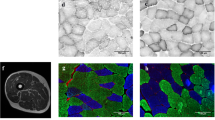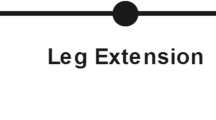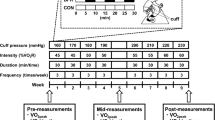Summary
The effects of 8 weeks of bicycle endurance training (5 x /week for 30 min) on maximal oxygen uptake capacity (\(\dot V_{O_{2max} } \)) during arm and leg ergometry, and on the ultrastructure of an untrained arm muscle (m. deltoideus), and a trained leg muscle (m. vastus lateralis) were studied. With the training, leg-\(\dot V_{O_{2max} } \) for bicycling increased by +13%, while the capillary per fiber ratio and the volume density of mitochondria in m. vastus lateralis increased by +15% and +40%, respectively. In contrast, the untrained m. deltoideus showed an unchanged capillary per fiber ratio and a decreased mitochondrial volume density (−17%). Despite this decrease of mitochondrial volume arm-\(\dot V_{O_{2max} } \) increased by +9%. It seems unlikely that the observed discrepancy can be explained by cardiovascular adaptations, since arm cranking did not fully tax the cardiovascular system (arm-\(\dot V_{O_{2max} } \)/leg-\(\dot V_{O_{2max} } \): 0.74 and 0.71 before and after training, respectively). Thus neither cardiovascular adaptations nor local structural changes in the untrained muscles could explain the increased arm-\(\dot V_{O_{2max} } \). However, the enhanced capacity for lactate clearance after endurance training could be sufficient to account for the larger\(\dot V_{O_{2max} } \) during arm cranking. We propose that an increased net oxidation of lactate might be responsible for the increased arm-\(\dot V_{O_{2max} } \) found after bicycle endurance training.
Similar content being viewed by others
References
Ahlborg G, Hagenfeld L, Wahren J (1975) Substrate utilization by the inactive leg during one-leg or arm exercise. J Appl Physiol 39:718–723
Andersen P, Henriksson J (1977) Capillary supply of the quadriceps femoris muscle of man: adaptive response to exercise. J Physiol [Lond] 270:677–690
Bar-Or O, Zwiren LD (1975) Maximal oxygen consumption test during arm exercise — reliability and validity. J Appl Physiol 38:424–426
Bergström J (1962) Muscle electrolytes in man. Scand J Clin Lab Invest 68:[Suppl] 1–110
Blomqvist CG, Saltin B (1983) Cardiovascular adaptations to physical training. Ann Rev Physiol 45:169–189
Clausen JP, Klausen K, Rasmussen B, Trap-Jensen J (1973) Central and peripheral circulatory changes after training of the arms or legs. Am J Physiol 225:675–682
Davis JA, Vodak P, Wilmore JH, Vodak J, Kurtz P (1976) Anaerobic threshold and maximal aerobic power for three modes of exercise. J Appl Physiol 41:544–550
DiPrampero PE (1985) Metabolic and circulatory limitations to\(\dot V_{O_{2max} } \) at the whole animal level. J Exp Biol 115:319–331
Donovan CH, Brooks GA (1983) Endurance training affects lactate clearance, not lactate production. Am J Physiol 244:E83-E92
Gleser MA (1973) Effects of hypoxia and physical training on hemodynamic adjustments to one-legged exercise. J Appl Physiol 34:655–659
Gollnick PD, Saltin B (1982) Significance of skeletal muscle oxidative enzyme enhancement with endurance training. Clin Physiol 2:1–12
HÄggmark T, Jansson E, Svane B (1978) Cross-sectional area of the thigh muscle in man measured by computed tomography. Scand J Clin Lab Invest 38:355–360
HÄggmark T, Jansson E, Eriksson E (1981) Fiber type area and metabolic potential of the thigh muscle in man after knee surgery and immobilization. Int J Sports Med 2:12–17
Henriksson J (1977) Training induced adaptation of skeletal muscle and metabolism during submaximal exercise. J Physiol [Lond] 270:661–675
Henriksson J, Reitman JS (1977) Time course of activity changes in human skeletal muscle succinate dehydrogenase and cytochrome oxidase activities and maximal oxygen uptake with physical activity and inactivity. Acta Physiol Scand 99:91–97
Hoppeler H, Mathieu O, Krauer R, Claassen H, Armstrong RB, Weibel ER (1981) Design of the mammalian respiratory system. VI. Distribution of mitochondria and capillaries in various muscles. Respir Physiol 44:87–111
Hoppeler H, Lindstedt SL, Uhlmann E, Niesel A, Cruz-Orive LM, Weibel ER (1984) Oxygen consumption and the composition of skeletal muscle tissue after training and inactivation in the European woodmouse (Apodemus sylvaticus). J Comp Physiol B 155:51–61
Hoppeler H, Howald H, Conley K, Lindstedt SL, Claassen H, Vock P, Weibel ER (1985) Endurance training in humans: Aerobic capacity and structure of skeletal muscle. J Appl Physiol: Respirat Environ Exercise Physiol [in press]
Houston ME, Bentzen H, Larsen H (1979) Interrelationships between skeletal muscle adaptations and performance as studied by detraining and retraining. Acta Physiol Scand 105:163–170
Howald H, Hoppeler H, Claassen H, Mathieu O, Straub R (1985) Influence of endurance training on the ultrastructural composition of the different muscle fiber types in humans. Pflügers Arch 403:369–376
Ikai M, Fukunaga T (1968) Calculation of muscle strength per unit cross-sectional area of human muscle by means of ultrasonic measurement. Int Z Angew Physiol Arbeitsphysiol 26:26–32
Ingjer F (1979) Effects of endurance training on muscle fibre ATP-ase activity, capillary supply and mitochondrial content in man. J Physiol [Lond] 294:419–432
Lewis S, Thompson P, Areskog NH, Vodak P, Marconyak M, DeBusk R, Meilen S, Haskell W (1980) Transfer effects of endurance training to exercise with untrained limbs. Eur J Appl Physiol 44:23–34
Mathieu O, Krauer R, Hoppeler H, Gehr P, Lindstedt SL, Alexander RMcN, Taylor CR, Weibel ER (1981) Design of the mammalian respiratory system. VII. Scaling mitochondrial volume in skeletal muscle to body mass. Respir Physiol 44:113–128
Poortmans JR, Delescaille-Vanden Bossche J, Leclercq R (1978) Lactate uptake by inactive forearm during progressive leg exercise. J Appl Physiol: Respirat Environ Exercise Physiol 45:835–839
Saltin B, Nazar K, Costill DL, Stein E, Jansson E, Essen B, Gollnick PD (1976) The nature of the training response; peripheral and central adaptations to one-legged exercise. Acta Physiol Scand 96:289–305
Saltin B (1985) Malleability of the system in overcoming limitations: Functional elements. J Exp Biol 115:345–354
Sawka MN, Foley ME, Pimental NA, Toner MM, Pandolf KB (1983) Determination of maximal aerobic power during upper-body exercise. J Appl Physiol: Respirat Environ Exercise Physiol 54:113–117
Weibel ER (1979) Stereological methods. Vol. I: Practical methods for biological morphometry. Academ Press, London, New York, Toronto
Weibel ER, Taylor CR, Gehr P, Hoppeler H, Mathieu O, Maloiy GMO (1981) Design of the mammalian respiratory system. IX. Functional and structural limits for oxygen flow. Respir Physiol 44:151–164
Yoshida T, Takeuchi N, Suda Y (1982) Arterial versus venous blood lactate increase in the forearm during incremental bicycle exercise. Eur J Appl Physiol 50:87–93
Ziada AMAR, Hudlicka O, Tyler KR, Wright AJA (1984) The effect of long-term vasodilatation on capillary growth and performance in rabbit heart and skeletal muscle. Cardiovasc Res 18:724–732
Zumstein A, Mathieu O, Howald H, Hoppeler H (1983) Morphometric analysis of the capillary supply in skeletal muscles of trained and untrained subjects — Its limitations in muscle biopsies. Pflügers Arch 397:277–283
Author information
Authors and Affiliations
Additional information
This work was supported by grant 3.128.81 from the Swiss National Science Foundation, and by Cilo S.A., Bicycles, Romanel/Switzerland
Rights and permissions
About this article
Cite this article
Rösler, K., Hoppeler, H., Conley, K.E. et al. Transfer effects in endurance exercise. Europ. J. Appl. Physiol. 54, 355–362 (1985). https://doi.org/10.1007/BF02337178
Accepted:
Issue Date:
DOI: https://doi.org/10.1007/BF02337178




